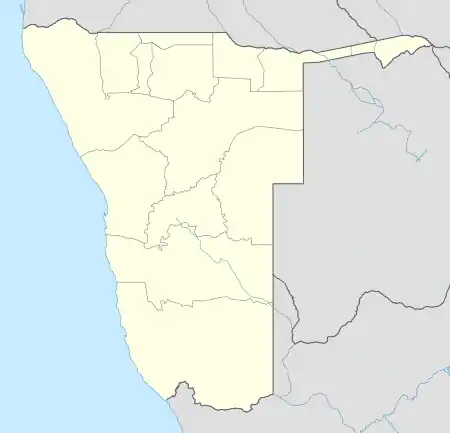 Aerial view of Rosh Pinah town and zinc mine | |
| Location | |
|---|---|
 Rosh Pinah mine | |
| Location | Rosh Pinah |
| Region | ǁKaras Region |
| Country | Namibia |
| Coordinates | 27°57′18″S 16°45′50″E / 27.955°S 16.764°E |
| Production | |
| Products | Lead Zinc Silver |
| History | |
| Opened | 1969 |
| Owner | |
| Company | Appian Capital Advisory LLP (90%) |
| Website | www |
The Rosh Pinah mine is a mine near Rosh Pinah in the ǁKaras Region of southern Namibia. It is one of the largest and most important lead and zinc mines in Namibia. The mine is located in the extreme southwest, about 20 kilometres (12 mi) north of the Orange River and 50 kilometers east of the Atlantic.[1] The mine is owned by Appian Capital Advisory LLP since 2023.
History
German-born Jew Mose Kohan discovered zinc in the nearby Hunz Mountains in 1963. He also coined the name "Rosh Pinah" which is a Hebrew term for "cornerstone".[2] The mine has been in continuous operation since 1969.[3]
Glencore acquired 50.04% ownership of the mine in 2011 and increased its stake shortly thereafter to 80.08%. The remainder of the shares were owned by Black Economic Empowerment (BEE) actors PE Minerals, owned by Aaron Mushimba, Jaguar Investments Four, and a trust representing mine employees.[4] In June 2014, Glencore announced laying off 124 employees from the Rosh Pinah mine.[5]
In 2017 Glencore sold its majority stake along with other zinc assets to Trevali Mining Corporation for $400 million.[6][7] In May 2018, Trevali increased its ownership to 90%.[8] In 2020, Trevali Mining Corporation launched a drilling study to consider the expansion of the mining reserve,[9] a project forecasted to cost $93 million.[10] In June 2023, private equity company Appian Capital Advisory acquired the company.[11]
Minerals
The mine has reserves amounting to 14 million tonnes of ore grading 2% lead and 8% zinc thus resulting 280,000 tonnes of lead and 1.12 million tonnes of zinc.[1] The mine also produces copper, silver and gold as byproducts.
Environmental impact
Decades of mining lead and zinc in this mine have led to chronic lead exposure of Rosh Pinah's inhabitants. In 2020, a report was compiled by the company medical practitioner of the zinc mine, confirming chronic lead exposure of all 30 children that were tested. The report was not published, and the doctor was dismissed. When the lead poisoning came to light in 2023, accounts from local doctors hint at hundreds of cases over several years.[12][13]
See also
References
- 1 2 "Mining in Namibia" (PDF). gsn.gov.na. 2012. Retrieved 25 June 2013.
- ↑ Tonchi, Victor L., William A. Lindeke, and John J. Grotpeter, "Rosh Pinah Mine" Historical Dictionary of Namibia. 2nd edition. (2012) Toronto: The Scarecrow Press, Inc, p. 373.
- ↑ "Rosh Pinah mine". Trevali Mining Corporation. Retrieved 11 May 2019.
- ↑ "Glencore buys 80% of Rosh Pinah". The Namibian. Mining Weekly. 16 December 2011.
- ↑ "Glencore to Cut 124 Jobs at Rosh Pinah Zinc Mine in Namibia". Bloomberg.com. 3 June 2014. Retrieved 24 November 2020.
- ↑ Burger, Schalk (1 September 2017). "Glencore sells zinc mines to Trevali for $400m". Engineering News.
- ↑ Namibian, The. "It's business as usual at Rosh Pinah mine". The Namibian. Retrieved 24 November 2020.
- ↑ Vuuren, Richard Jansen van (2 May 2018). "Trevali Mining increases stakeholding in Rosh Pinah Zinc". Miningreview.com. Retrieved 24 November 2020.
- ↑ Corporation, Trevali Mining (26 February 2020). "Trevali Announces Drill Results Extending the Western Orefield Deposit at Rosh Pinah at Depth and Along Strike". GlobeNewswire News Room (Press release). Retrieved 24 November 2020.
- ↑ Ecofin, Agence. "Namibie : Trevali devra investir 93 millions $ pour son projet d'extension à la mine Rosh Pinah (PFS)". Agence Ecofin (in French). Retrieved 24 November 2020.
- ↑ "Appian announces strategic investment in the operating Rosh Pinah zinc mine in southwestern Namibia". PR Newswire (Press release).
- ↑ Alberts, Ellen (13 July 2023). "Rosh Pinah children suffer chronic lead exposure". The Namibian.
- ↑ Klukowski, Steven (12 October 2023). "Rosh Pinah lead exposure alarming". New Era.